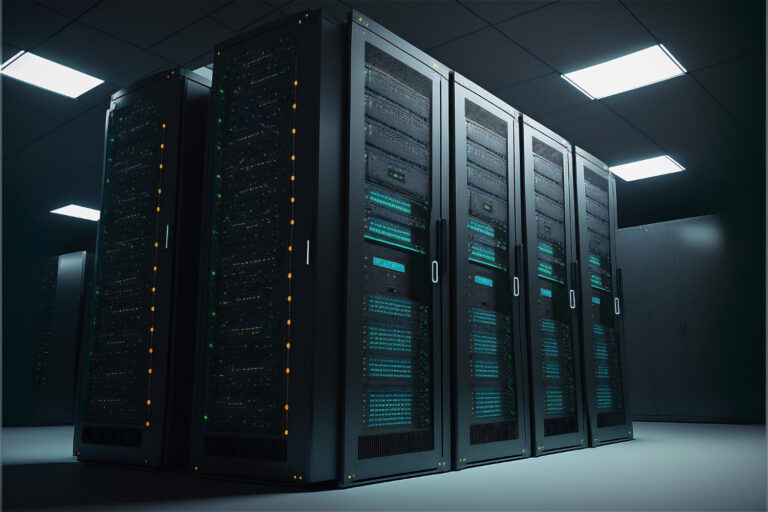

A server rack is a structure or cabinet designed to house and organize server equipment. It is typically used in data centres and networking environments to provide a centralized location for storing and managing various servers, networking devices, and other equipment. The server rack plays a crucial role in maintaining the efficient operation of a data center or networking environment. The servers are placed in racks, which are then arranged in rows. These racks provide a secure and organized space for the servers, while also allowing for easy access and management of the equipment. Server racks come in various sizes and configurations, with the most common being a 19-inch wide rack. This standard size allows for compatibility and flexibility when it comes to choosing and installing server equipment.
Server racks are tall cabinets that house servers and other networking equipment. They are typically found in data centers, but they can also be found in smaller businesses and offices. Server racks are used to keep servers organized and protected from the environment.
Server racks come in a variety of sizes and configurations. Some server racks are designed to hold a single server, while others can hold dozens of servers. Server racks can also be customized to meet the specific needs of a business or organization.
Here are some of the benefits of using server racks:
- Organization: Server racks help to keep servers organized and easy to access. This can make it easier to troubleshoot problems and to add or remove servers as needed.
- Protection: Server racks protect servers from the environment, such as dust, dirt, and moisture. They also provide a secure place to store servers and to prevent unauthorized access.
- Cooling: Server racks typically have built-in fans to help cool servers. This is important because servers can generate a lot of heat, and overheating can damage them.
Server racks are an essential part of many businesses and organizations. They help to keep servers organized, protected, and cool.
In addition to housing servers, server racks also serve as a means of providing power and cooling to the equipment. One important aspect of server racks is their ability to provide power and cooling to the servers. The power supply to the servers and cooling systems in a rack is essential in ensuring the proper functioning and longevity of the equipment.
This is particularly important for blade servers, which are densely packed with components and require effective cooling. Blade servers, while compact and efficient in terms of space utilization, can be challenging to cool due to their densely packed components. For example, a rack with 42U (rack unit) can accommodate up to 60 blade servers. However, this high-density configuration requires a significant amount of power supply and cooling compared to racks with 1U servers.
In the fast-paced digital landscape, businesses rely heavily on data management and seamless connectivity. Central to this infrastructure is the often overlooked yet crucial component – the server rack. A well-chosen server rack not only ensures efficient space utilization but also plays a pivotal role in maintaining optimal performance and scalability. In this guide, we’ll delve into the essentials of selecting and maintaining the right server rack to meet your business needs.
Choosing the Right Server Rack
- Consider Your Business Requirements: Before diving into options, assess your business’s current and future data storage needs. Factors like the number of servers, anticipated growth, and power distribution requirements should guide your decision.
- Size and Space Optimization: Server rooms or data centers are often constrained by space. Opt for rack sizes that align with your available space while allowing easy access for maintenance. Vertical and wall-mounted racks are great space-saving alternatives.
- Airflow and Cooling: Overheating can lead to hardware failure and downtime. Choose racks with proper ventilation and cable management to optimize airflow. Additionally, consider racks with cooling options, such as built-in fans or cooling units, especially for high-density setups.
- Scalability: As your business grows, so will your IT infrastructure. Select a rack that accommodates future expansion, whether through additional rack units (U-space) or compatibility with accessories like shelving and cable organizers.
- Security and Accessibility: Depending on your industry, security might be a top concern. Look for racks with locking mechanisms to safeguard your equipment. Moreover, easy accessibility to components ensures streamlined maintenance.
Types of Server Racks
- Open Frame Racks: Ideal for small businesses, these racks offer easy access, airflow, and cost-effectiveness. They’re suitable for non-sensitive environments.
- Closed Racks (Cabinets): Providing enhanced security, closed racks come with lockable doors. They’re suitable for businesses with higher security requirements or those in regulated industries.
- Wall-Mounted Racks: When floor space is a premium, wall-mounted racks are a great choice. They are perfect for networking equipment and smaller setups.
- Enclosed Racks with Cooling: For businesses running high-performance servers, these racks offer built-in cooling systems to prevent overheating.
Maintenance and Best Practices
- Regular Inspections: Schedule routine checks to identify any loose cables, potential overheating issues, or worn-out components.
- Cable Management: Well-organized cables not only ensure proper airflow but also simplify future upgrades or replacements. Use cable trays and clips to manage cables efficiently.
- Temperature Monitoring: Invest in temperature monitoring systems to ensure your servers are operating within safe temperature ranges.
- Security Audits: Conduct periodic security audits to ensure the physical security of your equipment, especially if the rack contains sensitive data.
- Upgrades and Expansion: As your business needs evolve, plan for rack upgrades or expansion to accommodate new hardware seamlessly.
In the digital age, a reliable server rack forms the backbone of your IT infrastructure. By selecting the right type of rack, optimizing space, ensuring proper cooling, and practicing regular maintenance, you’ll create an environment that fosters consistent performance, scalability, and data security. Invest wisely in your server rack today for a more efficient and robust business tomorrow. For expert assistance and a wide range of server rack solutions, RankSparrow Technologies is here to help. Contact us to embark on the journey of transforming your IT infrastructure.